


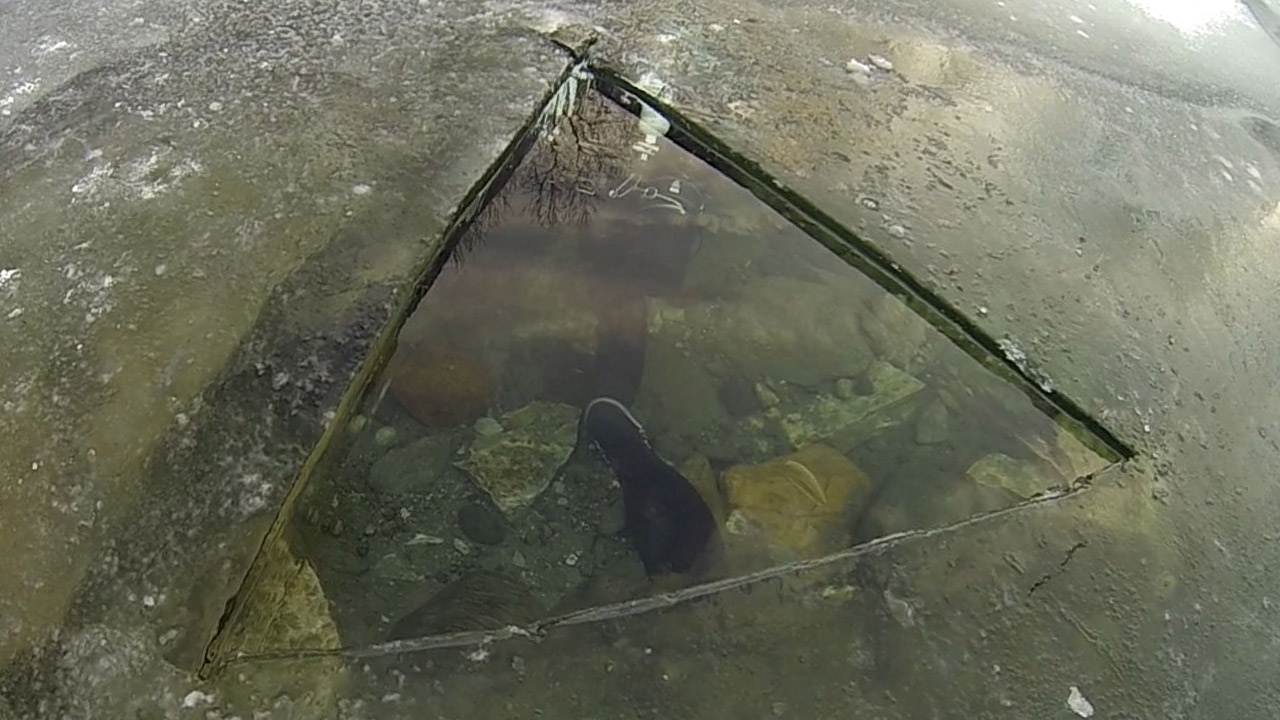
On 6 February 2014, five Finnish men embarked on a fateful dive in Plurdalen, Norway. Two of them were dead before the day was over, while the remaining three had to struggle in the freezing water for hours. What happened that day?
All had been going well until not so long ago, but then the dive started to go wrong.
Kai Känkänen had tried to help his fellow diver, but he had little time in the freezing water at a depth of over one hundred metres. Känkänen did as he had been trained to do: he had to save himself. He tried to stay calm and swam on.
Then he saw the body of another fellow diver.
Känkänen aimed his dive light at the squeeze and saw how the fourth member of the diving group tried to go around the body, his black rubber fins flapping frantically.
It seemed to Känkänen that the diver would soon exhaust himself and die.
What about the fifth diver? Where was he? It was unlikely that he was still alive, Känkänen reasoned.
Känkänen also thought he himself would die soon. There was no way forward, and his chances of making it back to the entrance were slim.
They had arrived past midnight, after a fifteen-hour drive through Finland, Sweden and Norway. They had stopped for supplies in Tornio, bought bacon and eggs for breakfast.
All five of them were travelling in the van of Jari Huotarinen, which was pulling a trailer full of gear: a snowmobile, underwater scooters, a few dozen large diving cylinders and various smaller equipment.
Road conditions had been slippery toward the end of their journey. Patrik Grönqvist had been sleeping on a slab placed over the equipment when the van began to skid on the icy Norwegian highway. Naturally, they had also experienced problems with the navigation system.
It was past one in the morning of 6 February when they finally arrived at the Jordbru farm in Rana, a municipality in the Norwegian county of Nordland. This is where the Plura cave is located.
Känkänen turned off the engine.
Five men, stiff from the journey, clambered out of the van. Kai Känkänen, a 46-year-old electrical contractor from Vantaa; Patrik Grönqvist, a 42-year-old fireman from Porvoo; Jari Huotarinen, a 40-year-old production manager from Valkeakoski; Vesa Rantanen, a 33-year-old electrical designer from Hämeenlinna; and Jari U., a 34-year-old mechanical engineer from Espoo, whose full name is not disclosed at the request of his family.
Känkänen had originally planned the trip for January but had to re-schedule it because many had prior commitments. Ultimately, it was by sheer coincidence that exactly these five men were there.
Some of them knew each other well, such as Grönqvist, Känkänen and Huotarinen, who had dived together a lot. Everyone, however, knew each other to some extent as, although technical diving is quite popular in Finland, the cave diving community has remained small due to the risks associated with the hobby.
Most cave divers practice at the Ojamo quarry in Lohja due to the lack of natural caves suitable for diving in Finland. The quarry is filled with clear groundwater and is suitable for diving also in the winter.
Cave diving is dangerous, as especially Känkänen had experienced first hand. One year earlier, he had lost his long-time diving partner in an accident at the Montola quarry in Pieksämäki, Central Finland. As they had lowered their gear through a hole in the ice into the water and were below the ice preparing for the dive, Känkänen noticed that his partner was not wearing a mouthpiece.
Känkänen pushed his partner onto the ice and began resuscitation. A rescue helicopter arrived eight minutes later, but it was unavoidably late.
The accident shocked Känkänen to the extent that he decided to quit diving. The hiatus, however, lasted no more than a couple of months; with all of his friends still diving, he was unable to give it up.
Later that year, Känkänen witnessed another fatal accident. A group of twelve Finnish divers – which also included Grönqvist, Huotarinen and Rantanen – had only begun their descent toward a shipwreck sited westerly from Tallinn when one of the divers disappeared.
After rescue officials were unable to discover the body, Känkänen, Grönqvist and Rantanen continued the search on their own, ultimately discovering the body at a depth of 70 metres.
Känkänen and Grönqvist were the most experienced divers of the group in Norway. It was them who had discovered the connection between the two known entrances to the Plura cave. They, alongside Sami Paakkarinen, were also the first to dive from one entrance to the other – thus conducting a so-called traverse, a great accomplishment in the cave diving community.
The plan of the five men was to conduct only the second traverse between the two entrances, the first one in this direction. The fact that the cave reaches a depth of over 130 metres makes the dive extremely challenging, while several squeezes and the cold water add to the difficulty.
They were to descend into the cave through an entrance located in a pond and dive 2,036 metres to the other entrance, situated roughly one hundred metres below the surface of the earth in the dry but difficult-to-reach cave Steinugleflåget.
The dive ahead was so difficult that perhaps no more than a dozen Finnish cave divers would have dared to undertake it.
In addition to Känkänen and Grönqvist, Huotarinen and Rantanen had prior experience of the Plura caves, although they had yet to venture so deep. Jari U. was the only one without prior experience of the cave, but he had dived in numerous quarries and caves in Finland as well as abroad and was known as a deliberate and pedantic diver who never rushed into action.
The group had laid out the details of the dive during the long drive. After diving through the cave, they would leave their equipment in Steinugleflåget, return the next day and dive back.
They would spend the night at the Jordbru farm.
Before turning in, they carefully carried the equipment from the trailer into a garage to ensure it was not ice-cold come morning.
With the exception of Huotarinen, who turned in immediately, they each had one beer; on the eve of a long dive, it is inadvisable to drink more. They also agreed not to get up until eight as it was important to rest well before a long dive.
The river Plura originates in the lake Kallvatnet, runs through the valley of Plura and terminates in the river Ranelva, north-east of the city of Mo i Rana. Plura was a large river still in the 1950s, before Kallvatnet was dammed, but today the riverbed is ever so often virtually dry.
At some stage of the geological history of Scandinavia, when Plura was still free-flowing, the water eroded the porous limestone, creating passages. As a result, parts of the river run beneath the ground surface.
The Kallvatnet dam has constrained the flow of the river to the extent that the cave is suitable for diving. Today, Plura is the largest water-filled natural cave in Northern Europe. It is both beautiful and exciting, although no fish or other life forms inhabit it.
Norwegian divers have explored the cave since the 1990s, laying guidelines as they discover new passages. In recent years, the cave has also begun to attract Finnish divers, who have run their own lines while exploring the caves. Some of them have advanced deeper than their Norwegian colleagues.
Having considered the Plura cave their own research project, the Norwegians would have preferred it had others not run their lines there. “According to an unwritten gentleman's agreement, no new lines should be laid if there's an ongoing exploration project in the caves,” says Jan Arild Aaserud of the Norwegian Reel Action Diving group.
“Finnish diving groups have disregarded this completely.”
The Norwegians, Aaserud says, wanted to discover the connection between the two entrances to the cave themselves. The Finns, however, beat them to it.
“In some sense, the goal was taken from right under our noses,” Aaserud says. “Efforts of over ten years became worthless.”
It was -3 degrees Celsius outside on the morning of 6 February. The sun did not break above the fells until nine in the morning. There would be no more than seven hours of daylight, but the day would be bright.
Jari U. had already made breakfast, cooked porridge for everyone, as the most talkative member of the group, Vesa Rantanen, woke up. Patrik Grönqvist, in turn, had already gone for a run to examine the ice conditions at the pond.
The group divided into two: Känkänen, Rantanen and Jari U. left to take equipment down to the Steinugleflåget cave. The five men would eat and change into dry clothes there after the dive, before climbing back to the surface and returning to their lodgings.
Grönqvist and Huotarinen were left with the task of cutting a hole in the ice with a chainsaw.
There was snow aplenty everywhere. The northern sun shone low.
Grönqvist was in a good mood. “Alright Hamsteri, start the saw,” he said to Huotarinen.
Hamsteri (hamster) was one of Huotarinen's nicknames. It remains somewhat unclear how it related to the fact that Huotarinen was known as a laid-back and calm diver. Huotarinen was never far from the action but did not flinch easily. Huotarinen and Grönqvist had made long dives together in Finland and abroad.
A few years earlier, Huotarinen and Känkänen had made an unofficial Finnish record by diving to the depth of 210 metres in the Hälvälä quarry in Eastern Finland. After the eight-hour dive, Huotarinen had to be treated for severe decompression sickness in a recompression chamber in Helsinki.
The spouse of Huotarinen had also dived regularly but had less time for diving after the birth of their first-born a few years ago. Everyone had noticed this, although domestic matters are rarely discussed within the community.
Huotarinen was hauling a sledge full of equipment onto the ice. The ice was dozens of centimetres thick and the guide bar of the chainsaw barely long enough to penetrate it. As water sprinkled over the ice, the thin layer of snow covering it melted, revealing a spectacular sight: it was possible make out the rocky bottom of the pond through 150 centimetres of clear water. The rocks were well-defined, as if seen through a gigantic magnifying glass.
Footage shot by Grönqvist shows how he and Huotarinen prepared for the dive. They assembled their gear routinely, as if they were about to go fishing. They only exchanged a couple of words while helping each other with the gear. Huotarinen slid up the zipper on the back of Grönqvist's dry suit.
Grönqvist then pointed his camcorder at Huotarinen, who was sitting on the snowy bank of the pond in full preparedness.
“What do you think?” Grönqvist asks. “Should we wait or go?”
Huotarinen responds by gesturing down with his right hand.
“I agree,” Grönqvist says.
It is beautiful. The river flows quietly between the fells. The sun is shining, only light clouds cover the sky.
The camcorder rolls.
“Famous cave diver Hamsteri,” Grönqvist says. Huotarinen chuckles and stands up.
Grönqvist points his camera at the hole in the ice.
“The hole. Damn, how clear it is!”
The water was indeed remarkably clear.
As Jari Huotarinen dived under the ice, Patrik Grönqvist stood by the hole holding the camcorder. The thick ice glimmered like a turquoise crystal.
In a report about the course of events presented to the Finnish Divers' Association, the survivors describe this part of the dive as follows:
The first team starts to make a hole in the ice at the Plura start site, while the second team transports the change of clothes and gear to Steinugleflåget. The second team returns to the Plura start site and helps the first team begin their dive.
Huotarinen and Grönqvist were preparing to take off below the ice as Jari U. and Kai Känkänen arrived. Vesa Rantanen had returned to the Jordbru farm to fetch his dry suit.
Jari U. peered into the hole, at the black fins of Grönqvist. “The water's really clear,” he said, smiling.
Känkänen aimed the camcorder at the hole. “Patte and Jari Huotarinen about to take off towards Steinugleflåget. They'll rest in the water for a while.”
Below the ice, Grönqvist and Huotarinen proceeded toward the entrance to the cave. They both used an underwater scooter to move faster and to conserve their strength, for any excess physical stress under high water pressure conditions was dangerous.
The ability to move like that, unrestrained, under water is what people have always dreamt of. It took a while for the dream to become reality.
First, people ventured under water inside large diving bells, which allowed them to explore depths of up to two-dozen metres while breathing the air trapped inside the bell.
The first diving dress was manufactured in the 19th century but required that divers remain in an upright position. Their air supply was replenished from the surface via a hose attached to the helmet and the air they exhaled was released into the water through a one-way valve. The next advancement was attaching the helmet to the dress with a collar.
The first diving cylinders were developed in time for the First World War, while soldiers in the Second World War already had safer and more effective diving equipment at their disposal. Divers using such open-circuit equipment inhale high-pressure air and exhale it into the water in a cloud of bubbles.
Similar diving equipment is used today by novice divers. Most divers in Finland never require other types of equipment because by completing an advanced course in scuba diving they are allowed to dive to a depth of 40 metres.
Diving beyond a depth of 40 metres is referred to as technical diving. It requires special training as instead of high-pressure air, divers breath a mixture of oxygen, nitrogen and helium – so-called trimix – in accordance with the depth of the dive. At such depths, the risks associated with diving increase and the ascent may take hours.
The Finnish divers in Norway were all experienced technical divers and certified CCR Full Cave Divers.
Istead of open-circuit equipment, they dived with closed-circuit equipment, or rebreathers.
The difference between an open-circuit and closed-circuit breathing apparatus is considerable. A rebreather does not discharge the air exhaled by the diver but recycles it after adding oxygen and absorbing the carbon dioxide it contains. As a result, divers need fewer gas cylinders, can fit through smaller openings and can stay submerged notably longer than with open-circuit systems.
Rebreathers are typically operated with a computer attached to the wrist of the diver. Although prices have decreased, such systems continue to cost thousands of euros, substantially more than open-circuit systems.
They also entail greater risks. As rebreathers naturally increase the risks of a dive, divers must first consider whether or not they need such equipment for their hobby, one manufacturer states on its website.
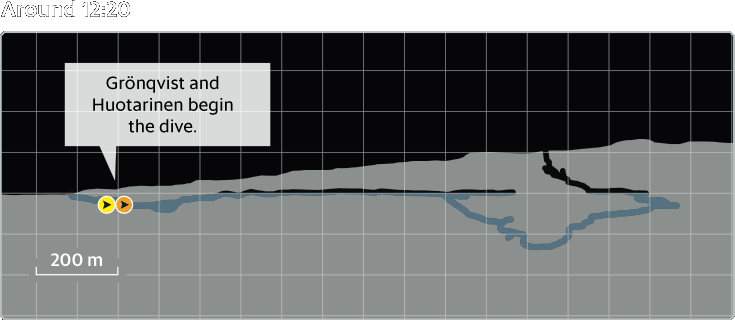
As Grönqvist and Huotarinen entered the cave, they were equipped with such closed-circuit breathing systems. Grönqvist had acquired his first rebreather nine years ago, Huotarinen seven years ago.
They had also devised a bailout, or reserve gas, strategy: they carried a third rebreather system and open-circuit gas cylinders to cope with a possible failure in their primary equipment.
It was past midday on Thursday, 6 February. They had estimated that the dive would last five hours.
Patrik Grönqvist is employed as a fireman at the Erottaja Rescue Station. He used to ride a bicycle to work even when he still lived in central Porvoo, a one-way commute of 50 kilometres. After a long shift in the winter, the ride home felt rough.
Grönqvist, a Finland-Swede, is married with three school-aged children.
He was not only in the best physical condition of the five divers in Norway but also the most experienced, having dived for 17 years both on and off duty. He had begun by diving shipwrecks in the Gulf of Finland and off the Norwegian coast, and later in the Mediterranean.
“I've also dived in warm waters, but I'm not particularly interested in fish,” he says. “Everything looks better in the dark, when you aim a light at it.”
“The feeling of weightlessness is the best. Diving is all about learning to control it. A good diver makes a kick and moves forward slowly and unhurriedly.”
Caves, he says, are now the most difficult places in the world to reach, following the introduction of commercial space flights. “If you happen to get into a cave where no one has ever been before, it's fun.”
He got to experience such a moment in September 2013, when he discovered the connection between Plura and Steinugleflåget.
He has dived in Spain, France, the Red Sea, the United States, Mexico. “The most beautiful caves I saw in Mexico, but they are so easy to access that almost anyone can get there.”
“Plura is different.”
Diving through the underwater entrance to the Plura cave, the daylight fades quickly. Footage of the dive shows how endless undulating strips of limestone line the walls and ceiling of the cave. In between, are water-burrowed holes that make the walls appear as if sculpted with a carpenter's hatchet.
Divers must beware of the schists of limestone lying on the floor as in the two-degree water a tear in the dry suit would be fatal.
The cave descends gradually to a depth of 34 metres over the first 500 metres before ascending briefly to a 250 metre long barren chamber filled only partly with water. This part of the cave is suitable also for less experienced divers.

After the air chamber, the cave begins to descend steeply, first reaching a depth of 60 metres, then 100 metres and finally 130 metres. The depths are measured from the entrance of the cave.
Only very experienced cave divers should venture so deep. Formed by water erosion, the openings are often but narrow clefts that require divers to use their hands to edge their way through. All around are treacherous side passages.
As Grönqvist and Huotarinen approached the deepest section of the cave, they turned off their underwater scooters to allow Huotarinen to admire the cave. At a depth of 130 metres, Grönqvist showed Huotarinen the deepest point of the cave. There, attached to the guideline were a round plate and two arrows pointing in the opposite direction - Grönqvist had attached them with Känkänen and Paakkarinen the previous autumn.
They had written the date and their initials with a water-proof marker on the small round plastic plate and, being unable to resist the temptation to jibe at their Norwegian colleagues, added the words Den jävla finne on the triangular directional marker.
Huotarinen shouted something through his mask, but Grönqvist cannot recall what. Divers can “talk” under water but as they are unable to move their lips freely due to their mouthpieces the words are garbled.
Overall, the cave remains below the depth of 100 metres for 400 metres. Grönqvist and Huotarinen had advanced over one kilometre from the entrance; it would not be long before they reached Steinugleflåget.
Grönqvist had agreed with Huotarinen that he would practice switching to the the bailout rebreather in the deep. The switch was a success, and he used his reserve system for a few minutes.
The passage began to ascend. At one point, it makes a 90-degree turn right while continuing to ascend. It is a narrow section, but not the narrowest on the route.
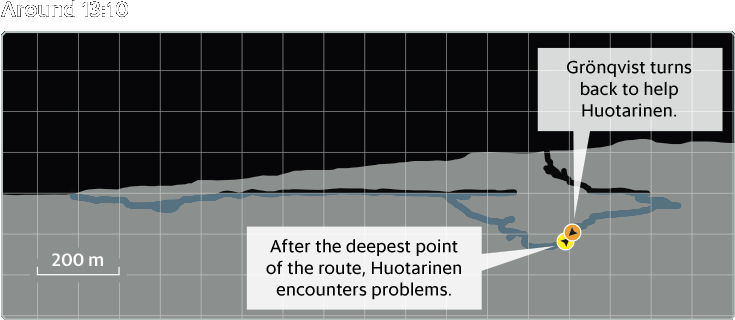
Grönqvist went first, but having made it through he realised the the light of Huotarinen was nowhere to be seen.
He turned around and waited.
“Then I saw Jari waving his light up and down,” Grönqvist describes.
That is the sign divers use to indicate distress.
“He screamed: 'Patte, come here!'”
Grönqvist turned back. They were now positioned face to face in the narrow passage. Huotarinen asked Grönqvist to detach one of his large bailout cylinders, which was apparently in the way. It was difficult to detach. Grönqvist moved his scooter out of the way.
“Jari kept yelling at me to come back. I shouted back that I won't be more than a couple of seconds, calm down.”
He swam back down the narrow passage to Huotarinen and moved the bailout cylinder roughly a dozen metres ahead next to his scooter.
He thought about yanking Huotarinen in case he was stuck but was concerned it could induce panic.
“I still didn't understand what he was doing there. Was he caught? It wasn't until then that I noticed that the line of his scooter was stuck under a big rock. Your scooter is stuck, I shouted.”
“Jari tried to yank it free by force. That was the end of that scooter, I thought. I still didn't understand how distressed he was.”
After the scooter came off, Grönqvist moved out of the way.
They were 111 metres below the surface.
Studies indicate that typically there is no single reason for diving accidents. What occurs first is a so-called trigger incident; the diver may for example run out of breathing gas or become entrapped.
A study into 947 fatal diving accidents in the United States in 1991—2003 found that in 20 per cent of accidents the trigger incident was entrapment and in over 40 per cent the insufficient supply of breathing gas.
If the diver fails to manage the unexpected situation and panics, the situation escalates quickly: trigger incident, disabling agent, disabling injury, actual cause of death.
The cause of death in 70 per cent of the accidents was drowning and in the remaining 30 per cent venous air embolism or heart attack.
In recent years, three to four Finns are believed to have died annually in technical diving accidents. No official statistics are maintained, however. Altogether, there are roughly 40,000 technical divers in the country.
Divers learning to use closed-circuit equipment also train for a variety of emergencies. A common emergency is the failure of the rebreather to efficiently absorb the carbon dioxide exhaled by the diver, resulting in hypercapnia.
Hypercapnia may also be self-induced if the diver panics and is no longer able to breathe regularly. In the deep, at a pressure far exceeding that on the surface, any excess physical stress may similarly cause the diver to breathe irregularly. To prepare for such circumstances, divers practice switching from rebreathers to open-circuit bailout cylinders in an attempt to reduce the concentration of carbon dioxide in their blood and to calm down.
Another possible emergency is acute oxygen intoxication. It can occur if the diver inhales oxygen at elevated partial pressures.
In general, both hypercapnia and oxygen intoxication occur without warning. The diver may not notice anything out of the ordinary until suddenly losing consciousness - the mouthpiece comes out, the diver inhales water and drowns.
After looking into the death of the diving partner of Kai Känkänen in the Montola quarry in early 2013, the police determined that the diver had forgotten to open the oxygen valve of his rebreather and consequently breathed the oxygen-poor mixture of nitrogen and and helium.
J
ari Huotarinen was calling for Patrik Grönqvist in the Plura cave.
“He shouted: give me the OC, the open-circuit bailout gas. I knew then that the situation was serious. I handed him the mouthpiece from my cylinder. Jari took maybe ten breaths and then switched back to the rebreather.”
The procedure was repeated two or three times. After noticing that Huotarinen had nothing in his mouth, Grönqvist placed a diving regulator over his mouth and pressed the purge button.
Huotarinen inhaled water.
It was all over.
Grönqvist grasped at a rock on the wall and tried to pull himself together.
As a rescue diver, he had seen dozens of bodies in water - people he did not know, who looked like dolls. He had seen dying patients in an ambulance - men and women he did not know.
Huotarinen was his friend.
He clung on to the rock. He realised that he was breathing fast. He had to calm down.
He looked at his dive computer, which measures the depth and time of a dive to determine the number and duration of decompression stops required for a safe ascent. Too direct an ascent increases the risk of developing potentially fatal decompression sickness.
The dive computer indicated that Grönqvist had to remain in the two-degree water for over 400 minutes before ascending safely to the surface – seven hours!
He stared at the screen in disbelief. Moments before the accident, the reading had been 120 minutes. How long had he stayed there? 15 minutes? 20 minutes?
Every minute spent at a depth of 110 metres and pressure of 12 bars adds over 10 minutes to the duration of the dive.
He could no longer swim back to tell the others what had happened. The way was blocked.
Grönqvist was already in danger: a dive that was supposed to last five hours would now take eight or nine hours. Even a minor equipment failure would probably cost him his life. He had a bailout system, but Huotarinen had the oxygen cylinder. He had also offered some of his bailout gas to Huotarinen.
He was horrified.
He began swimming toward Steinugleflåget.
He thought about the others, about what would happen when Känkänen, Rantanen and Jari U. discovered Huotarinen in two hours' time.
Grönqvist was afraid they would all die. He would have to drive the van of Huotarinen back to Finland alone. He thought about how after his return he would visit the homes of his four comrades, go from one house in mourning to another.

Kai Känkänen, Vesa Rantanen and Jari U. were ready to begin their dive. One by one, they lowered themselves under the ice and began their underground journey toward the Steinugleflåget cave.
It was a little past two in the afternoon.
The group had agreed that the second team would depart two hours after the first one in order to ensure that the sediment possibly stirred up by Grönqvist and Huotarinen has had time to settle.
Rantanen went first, while Jari U. and Känkänen followed him with their scooters. They reached the air chamber approximately 20 minutes after their departure and the second part of the cave, where the passage descends steeply, ten minutes later.
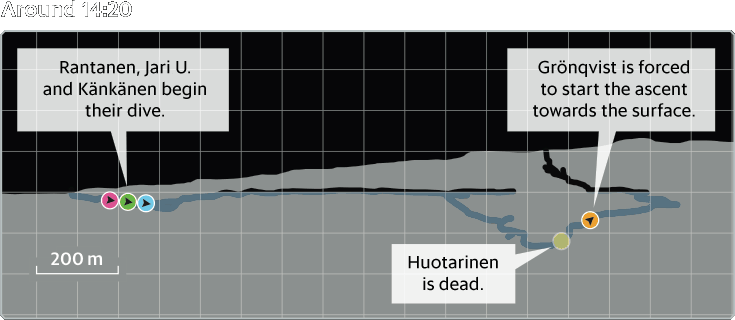
Känkänen brought up the rear because he wanted to ensure that the dives of Rantanen and Jari U. went according to plan.
It was typical of Känkänen. He was a meticulous diver, described as a quiet and diligent worker by his friends.
Känkänen recognised that the fact that they were carrying more bailout cylinders than during the maiden traverse in September would slow them down. The previous autumn, they had left bailout cylinders to both ends of the cave before diving and therefore needed fewer gas cylinders and only four hours to conduct the traverse.
This time, however, Rantanen had insisted on bringing five large cylinders for different depths as a precautionary measure, despite the warnings of Grönqvist and Känkänen that he may have to remove some of his equipment to fit through the narrow passage.
Känkänen was carrying one of the additional to allow Rantanen to move more freely.
At a depth of roughly 125 metres, Rantanen got stuck sliding through an opening less than one metre high.
“I tried to go through in the wrong position, even though we had talked about it in advance. I took off two cylinders before I realised how to dive through it,” Rantanen says.
Then one of his fins got tangled in the guideline.
“Take off my fin,” he bellowed to the ones behind, his voice sounding higher than usual due to the helium in the breathing gas. Jari U. disentangled the fin, but Rantanen was annoyed: five additional minutes at a depth of 125 metres translated to nearly one additional hour under water - and he hated performing decompression stops in cold water.
The thought of having to dive back to the same tunnel the next day began to aggravate him.
They descended to the deepest part of the cave and passed the round plastic plate attached to the guideline.
Den jävla finne.
Shortly thereafter, Rantanen heard a beep. He realised immediately that something was amiss; it was the distress signal of a breathing apparatus.
Then he saw the deceased. He tried not to look.
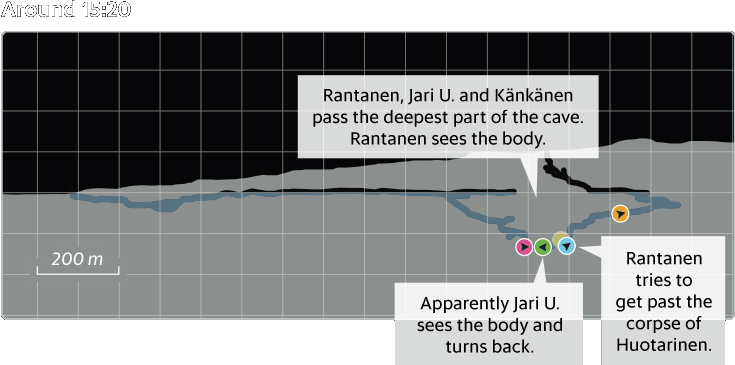
Vesa Rantanen had to find a way around the body Jari Huotarinen. He began to take off his gear to fit through the narrow opening.
He remembers seeing a light appear from behind him and shouting through his mask that Huotarinen was dead and that he would try to find a way around, but it did not look good.
What exactly happened next remains unclear. Kai Känkänen has no distinct recollection of the events due to shock and nitrogen narcosis, but as he caught up with Jari U. something was apparently amiss.
Känkänen tried to appease Jari U. by pointing his light at the guideline.
“I asked what's the matter. He yelled something, but I couldn't make out what.
Känkänen had yet to learn about the fate of Huotarinen, but had Jari U. seen the body and decided to turn back?
Jari U. was swinging peculiarly and switched from the closed-circuit system to his bailout system.
“I tried to calm him down by talking to him. I made sure that he wasn't trapped and that the bailout gas was on. I was flabbergasted,” Känkänen says.
“As the situation continued, I realised it couldn't be a failure in the rebreather.”
There was nothing he could do, and moments later Jari U. was dead.
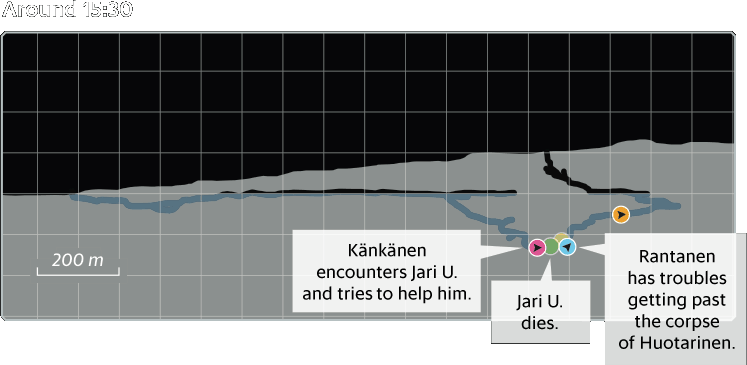
Känkänen realised he had to swim on.
Then, he saw the body of Huotarinen and next to it the fins of Rantanen, who was kicking fiercely to get around the body.
Känkänen shouted to Rantanen that also Jari U. was dead.
Let's turn back, he bellowed.
Rantanen heard him but dared not to turn back due to the way back being longer. He remembers breathing too heavily, exactly what one should not do.
It seemed to Känkänen that Rantanen was panicking. He was concerned Rantanen would exhaust himself.
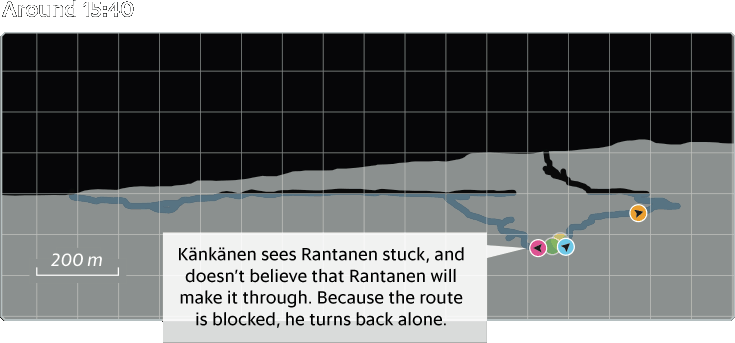
He had to make up his mind quickly whether or not to wait for Rantanen to find a way through.
Rantanen, he thought, was unlikely to make it.
He presumed also Grönqvist had died.
Känkänen turned back alone.
N
itrogen narcosis, or raptures of the deep, occurs in divers descending beyond depths of 30-40 metres as a consequence of the mixture of gases they inhale. It is impossible to predict the severity of the narcosis: its effect on the same diver may vary and it is impossible to develop a tolerance.
Technical divers seek to limit the narcotic effect by replacing some of the nitrogen in the breathing gas with helium. Helium, however, is considerably more expensive. The amount of helium needed for closed-circuit equipment is notably smaller than for open-circuit equipment, which is one reason why enthusiasts performing deep dives widely prefer rebreathers.
At best, nitrogen narcosis may have a calming effect. The diver feels good, in control of the circumstances. It is this sensation why many are so fond of diving.
On the other hand, the narcosis may impair the judgement and fine motor skills of divers, who as a result may lose their ability to assess the risks involved and to tie simple knots and locate familiar valves and couplings.
Some divers may lose their sense of directions, others their initiative. Some have to look frequently at the screen of their dive computer due to loss of memory.
In an emergency, small factors may prove fatal.
The five Finns exploring the Plura cave on 6 February were familiar with the effects of nitrogen narcosis.
“Nitrogen narcosis gives wings to your imagination,” Kai Känkänen says. “Your emotions are heightened in the depths: a matter that causes no anxiety on the surface can cause fear and anxiety. You must be able to contain yourself.”
Before the dive, all five of them had picked their own diluent gas. As no reliable research are available, divers must determine on the basis of their experiences which diluent gas to use and whether or not to change it during the dive. The partial pressure of oxygen, however, is automatically adjusted to the depth by the rebreather.
As Känkänen swam back toward the entrance, he was certain all four of his fellow divers had died. He weighed up his own chances of survival, determined that they were slim: he had two rebreathers but only little additional oxygen. One of the bailout cylinders was suitable only for deeper parts of the cave and could not be used during the ascent.
The first decompression stops would have to be made at a depth of roughly one hundred metres. The stops need be no longer than one minute at such depths but become longer as the ascent continues.
Känkänen had performed several deep dives but never before at such temperatures. He had also used what is known as an underwater habitat, an air-filled tent allowing divers to rest and even to drink and eat.
He continued to ascend steadily, irrespective of his dive computer indicating that he had to stop for an additional hour to decompress. He estimated, however, that he was more likely to run out of oxygen than to develop decompression sickness. He had had to skip a couple of decompression stops during his earlier dives but never as many as now. After reaching the air chamber, he decided to breath the air trapped inside to conserve his oxygen. He would have an unlimited supply of air should he decide to stay in the chamber, but how many days would he have to stay there?
If the others were dead, there would be no one on the surface to alert the rescue workers. No one would know he was alive. It could take a while for the rescue team to arrive as although the air chamber was not far from the entrance, it was nonetheless at a depth of over 30 metres.
Känkänen decided to move on.
His underwater scooter broke down shortly thereafter, slowing him down considerably. He had estimated that he could make it to the entrance from the air chamber in 15 minutes, but the journey took 45 minutes.
“I got really afraid that I would run out of oxygen. I swam the final stretch on a fluke.”
He knew that if the concentration of oxygen in the breathing gas is insufficient, the gas becomes hypoxic, he would gradually lose consciousness and ultimately drown.
Patrik Grönqvist could not ascend to the surface for several hours. What does one who believes his friends are dead do while waiting several hours in two-degree water?
Grönqvist thought about his family and drinking sprees with his friends. He held on to rocks on the walls as it is difficult to stay still in dark water. He could use the remaining battery power of his underwater scooter either for his light or thermal vest - but not simultaneously. It would be either cold or dark.
Every now and then, he swam around in circles. “I was so bloody scared none of them had made it out alive,” he says.
He had performed long decompression stops before but never before in such cold water.
Unbeknownst to him, Vesa Rantanen was making his own decompression stops behind him.
Rantanen stayed close to the guideline, occasionally lying still on the floor of the cave, waiting. When he was cold, he placed his hands against the wall and kicked.
He had acquired a new undersuit before the trip and had a sufficient supply of argon to inflate his suit to maintain his body temperature. He was wearing thinsulate gloves under the clumsy rubber gloves and woollen socks under his neoprene booties.
He had soon been under water longer than ever before, for over six hours.
At the other end of the cave, Kai Känkänen performed his own decompression stops while trying to make himself as comfortable as possible. He removed his excess equipment and attached them to the guideline.
It was terribly cold. The cold swept over him as soon as he stopped. He swam around to stay warm.
Occasionally, he positioned himself face against the ceiling of the cave. Whenever his fingers became cold, he raised his arms to allow the air inside the dry suit to rise to the fingers.
Rantanen was constantly plagued by guilt for having been unable to help Jari U.
He tried to guess what had happened and wondered whether Grönqvist had also died.
Hours passed.
He opened the valve of his last oxygen cylinder. It was difficult to make out the pointer on the oxygen gauge; he was not sure how much oxygen he had left.
He tried to think of something else. His spouse and three children were waiting home in Vantaa.
Under water, the human body is like a bottle of champagne. The pressure inside a champagne bottle is roughly 6 bars, equivalent to the water pressure at a depth of 50 metres. At such pressure, the gas inside is in liquid solution. When the bottle is opened, the pressure drops to 1 bar, causing the champagne to bubble intensely.
The same phenomenon occurs in divers who ascend to the surface too directly. Of the air inhaled by the diver in a high water pressure environment, the oxygen is transformed back to carbon dioxide while the nitrogen dissolves in blood. When the pressure drops abruptly, the nitrogen in the blood begins to form bubbles.
The result is decompression sickness: aching, prickling sensation on skin, numbness, respiratory difficulties and even paralytic strokes. The condition may be fatal.
A common rule of thumb taught to recreational divers is that the duration and maximum depth of a dive should never exceed the number 50. Therefore, a diver descending to a depth of 15 metres should not stay submerged for more than 35 minutes.
Patrik Grönqvist, Vesa Rantanen and Kai Känkänen had recently only now ascended from a depth of 130 metres - Känkänen both on his way in and out. They had swum 400 metres at a depth exceeding 100 metres - Känkänen twice as much.
Their stay at such depths had far exceeded what they had prepared for. They were exhausted and running out of oxygen and rebreather filters.
None of them was no longer able to perform the necessary decompression stops.
“I thought that if I could make it to six metres, I'm in the clear,” Grönqvist says.
Then he saw a light beneath him.
“I dived to maybe 12 metres. It was Vesku.”
Rantanen told Grönqvist that the others had turned back.
“It gave me strength, and I managed to make the stops nearly until the end.”
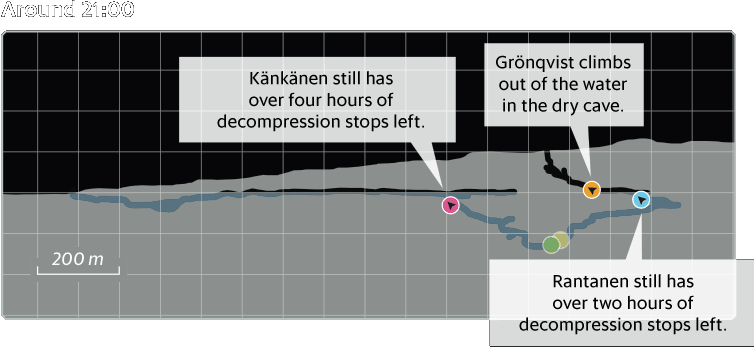
Patrik Grönqvist rose to the surface a little past nine o'clock in the evening, half an hour before it was safe. Instead of five, his dive had lasted eight and a half hours.
He sat down in the Steinugleflåget cave to wait for Rantanen. He rummaged the rucksacks his friends had left in the cave for something to drink. He had a vacuum-packed sausage in the pocket of his dry suit, as he always had because long dives work up his appetite.
Six metres below the surface, Rantanen saw the light from the headband lamp of Grönqvist as he sat in the cave, waiting for him.
At a depth of three metres, his arms began to ache, a sign of decompression sickness, he presumed.
Grönqvist had waited for Rantanen for an hour when he ascended to the surface, nearly 90 minutes before it was safe.
On the surface, the right knee of Rantanen began to ache.
Three hours later, Kai Känkänen emerged from the entrance of the cave to the pond. He aimed his light at the layer of ice above him and began to look for the dive hole.
He knew where it was supposed to be, but all he could see was ice. The hole they had cut in the morning had frozen shut.
Känkänen found the hole, but it was covered by a roughly one-centimetre layer of ice. He managed to break it, pushed his gear onto the ice and clambered out of the water.
There was no sign of anyone anywhere. It was half past one in the morning and dark.
His dive had lasted 11.5 hours.
He walked up to the van, his breathing apparatus still on his back. He tucked the apparatus into the boot of the vehicle and turned on the engine.
He switched the lights on.
Patrik Grönqvist and Vesa Rantanen were waiting at the Jordbru farm. After changing into dry clothes in Steinugleflåget, they had returned exhausted to the pond and waited.
Finally, they raised the alarm with the Norwegian authorities, afraid that no one would climb out of the hole.
It was nearly two in the morning when they noticed that someone had switched on the lights of the van. They ran up to the van through the snow.
Känkänen was lying on the floor and spoke English. He thought he was the only one who had made it out of the cave alive and assumed Grönqvist and Rantanen were locals.
Never again, he said, would he put his head under water.
News of the deaths of two Finns spread on Friday, drawing a lot of attention.
“Two Finnish divers died in accident in Nordland,” the Norwegian VG newspaper wrote.
“Two divers died in underwater cave – three hospitalised,” the Norwegian national broadcaster reported.
The police launched an investigation into the incident. Grönqvist, Rantanen and Känkänen were interrogated, while Rantanen was still being treated in a recompression chamber in Bergen, Norway.
The local authorities began to mull over how to retrieve the bodies of the victims from the cave. They decided to summon three experienced British divers to carry out the recovery operation - it was virtually the only alternative.
In February, the divers descended into the cave through the entrance in Steinugleflåget but were unable to dislodge the bodies. They considered the operation too dangerous.
Officials as a result decided to leave the bodies in the cave, imposing a diving ban and closing the area for visitors.
Plura would become a grave like the wreck of M/S Estonia.
It was springtime in Plurdalen, but underground it was the same as ever: dark, narrow, bleak and damp.
A group of Finns gathered at the Steinugleflåget cave on 26 March. The beams of their headband lamps illuminated the rocky chamber enveloping them.
They held a moment of silence for the memory of Jari U. and Jari Huotarinen.
Ten divers, including two women, and seven assistants participated. Some of them had not even met the victims.
Black rubber fins lay on top of one of the body bags.
Grönqvist, Känkänen and Rantanen were certain from the beginning that they would come back for their friends. On the night of the accident, Grönqvist had thought in Steinugleflåget that he would dive back for Huotarinen the next day.
Naturally, that was an absurd thought.
“I wanted to go back all the time. I couldn't think of anything else,” Grönqvist says.
After Norwegian authorities had decided to leave the bodies in the cave, Grönqvist sent a text message to some of his friends, asking if they wanted to participate. Everyone replied yes.
Kai Känkänen was similarly eager to return to Norway, although he had suffered from anxiety and had yet to dive after the accident. Rantanen, who was not allowed to dive due to decompression sickness, volunteered to assist, although he had been treated in a recompression chamber in Finland after experiencing tingling all over his body, difficulties walking and problems with his reflexes.
The major recovery operation had been kept secret from the authorities. Meanwhile, the preparations had been thorough. Divers would enter the cave from both entrances and leave 26 bailout cylinders inside the cave. An underwater habitat would be established roughly one kilometre from the pond to allow divers to rest while performing their decompression stops, if necessary.
Ultimately, it was Grönqvist and Sami Paakkarinen who retrieved the bodies. The victims were close to one another, in the same place as on the accident day.
The moment of silence was long.
The following morning, Sami Paakkarinen rang the authorities. The task of Norwegian rescue workers would be to transport the bodies out of the difficult-to-reach dry cave.
The operation drew a lot of media publicity. Although the bodies were retrieved against official orders, the actions of the divers did not come under criticism.
As they were carrying their gear out of the cave, roughly a dozen local residents came to help them. The owner of the Jordbru farm heated up the sauna.
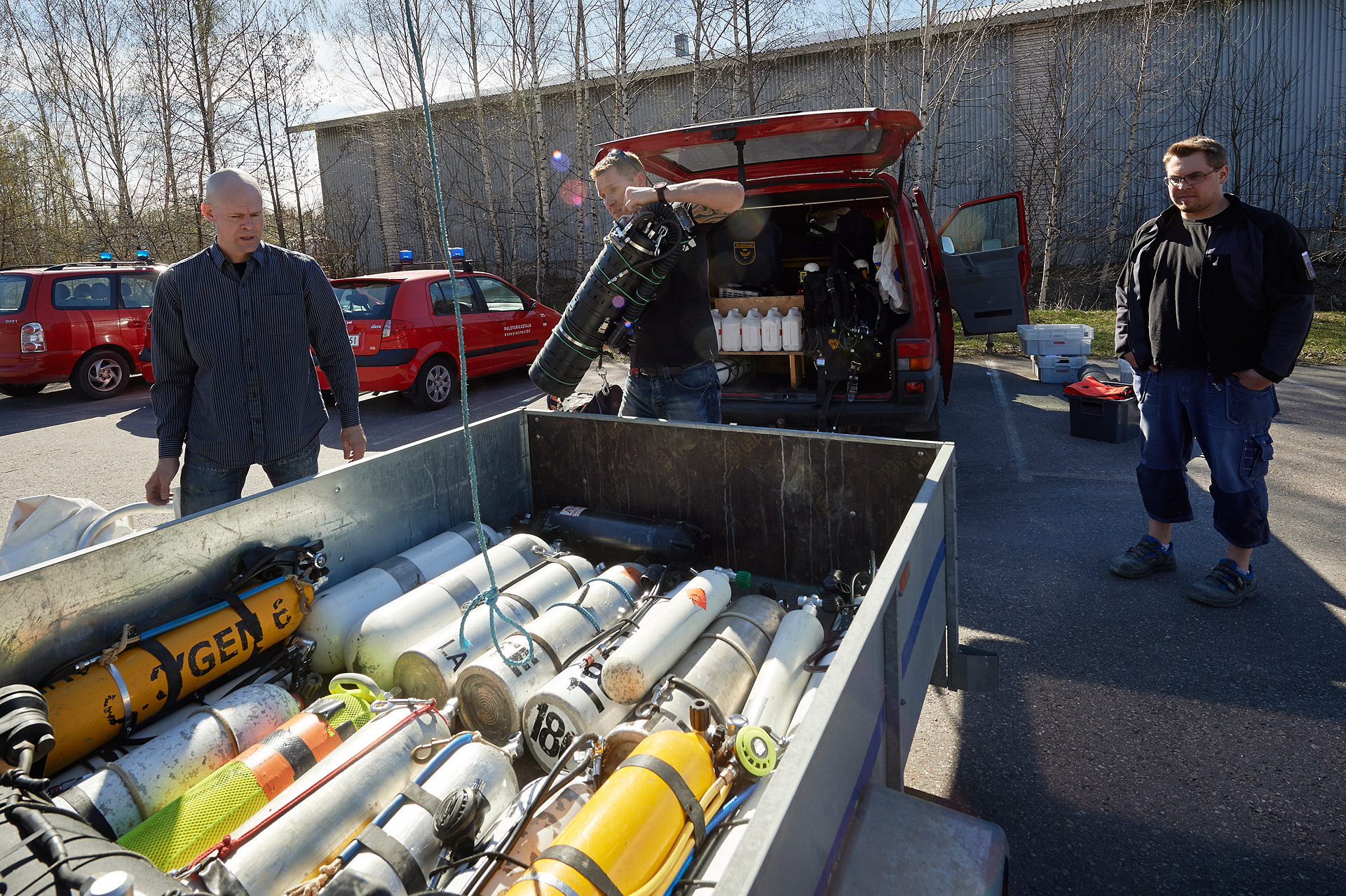
It is late April, and Patrik Grönqvist, Kai Känkänen and Vesa Rantanen are loading equipment onto a trailer attached to the van of Känkänen. Dozens of gas cylinders clank against one another.
“Cylinders go to the bottom,” Känkänen says. “Let's put the scooters on top.”
Grönqvist tosses several plastic cans containing white granules - quicklime for the rebreather filters - onto the trailer.
The three men are set to embark on a two-week cave diving trip to Spain and France. They had planned the trip since the previous autumn and thought seriously about calling it off after the accident in Plurdalen. Ultimately, they decided to go.
It has been two months and three weeks since the accident, and the bodies of the victims have been finally transported back to Finland. The first funeral was held earlier today.
They all participated in the service, Grönqvist as a pall-bearer. His dress uniform is hanging on a rack inside the van.
Later today, a ship will depart from the Vuosaari Harbour toward Germany. Thereon, the three men will drive to northern Spain, where the magnificent cave, Pozo Azul, is located. Cave divers have explored the cave since the 1970s, discovering a passage of over nine kilometres into the depths of the mountains.
No one has ventured deeper.